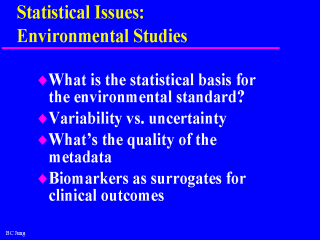| front |1 |2 |3 |4 |5 |6 |7 |8 |9 |10 |11 |12 |13 |14 |15 |16 |17 |18 |19 |20 |21 |22 |23 |24 |25 |26 |27 |review |
 |
G. van Belle notes that it is
important to understand the statistical basis for the standards used to induce compliance,
enforce correction action and to detect unacceptable environmental levels. Such standards
are defined to protect a sensitive subpopulation. How these standards are measured affects policy, enforcement and response. For example, manufacturers may get around regulations to reduce mass by increasing the number of ultrafine particles instead. G. van Belle emphasizes the need, when it comes to looking at environmental problems, to distinguish between variability (i.e., geographic distribution of PCB levels) vs. uncertainty (precision of the estimates of the levels). Ideally, we should use only the data we need to answer our research questions. However, given resource restraints we sometimes end up using available data sources which may not necessarily be always suitable for answering our research questions. Because such data were collected for other purposes, data fields may be different from what we want to know. Need to know the nature of the data in the database - the metadata. Biomarkers have not lived up to the original intent. Distinctions need to be made as to whether they are biomarkers of exposure, disease mechanism, or effect, since they serve different scientific purposes. Biomarkers of exposures and mechanisms have been found to be poor surrogates for clinical outcome. |